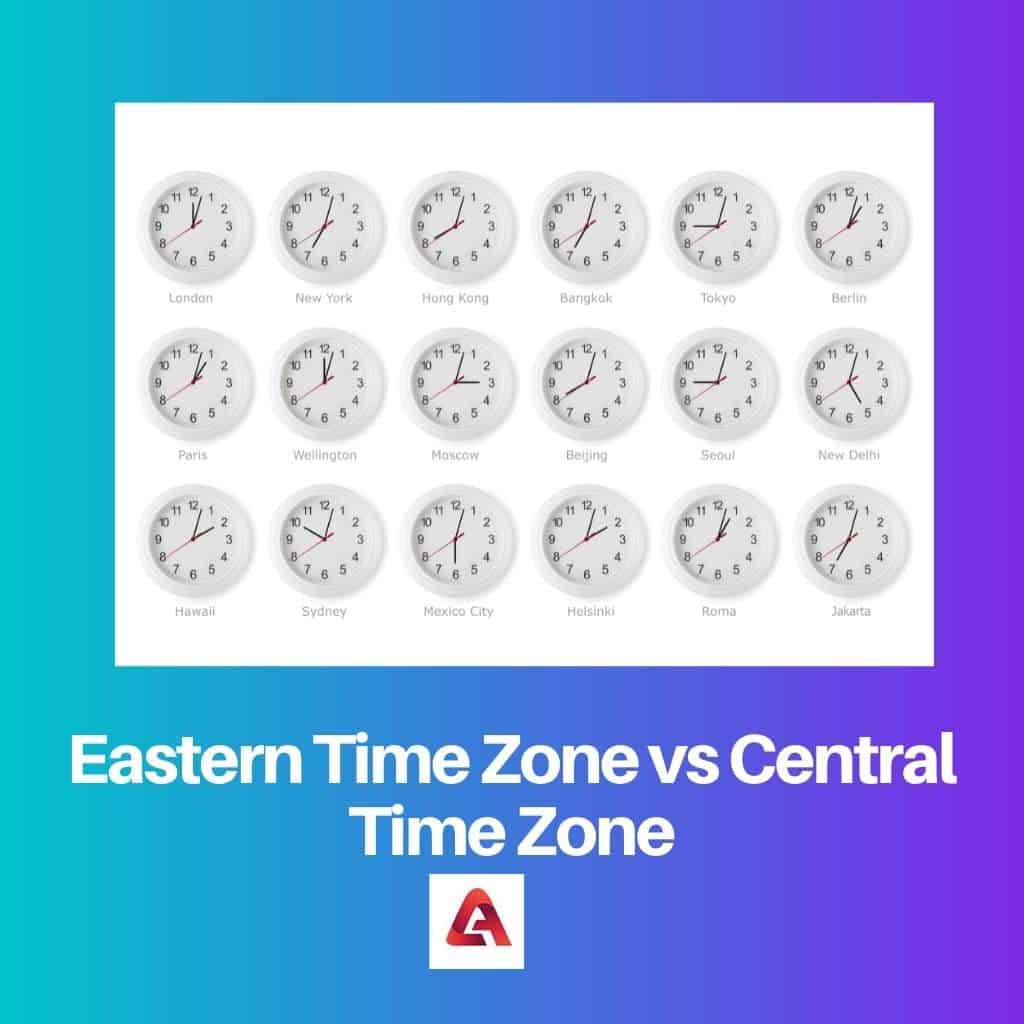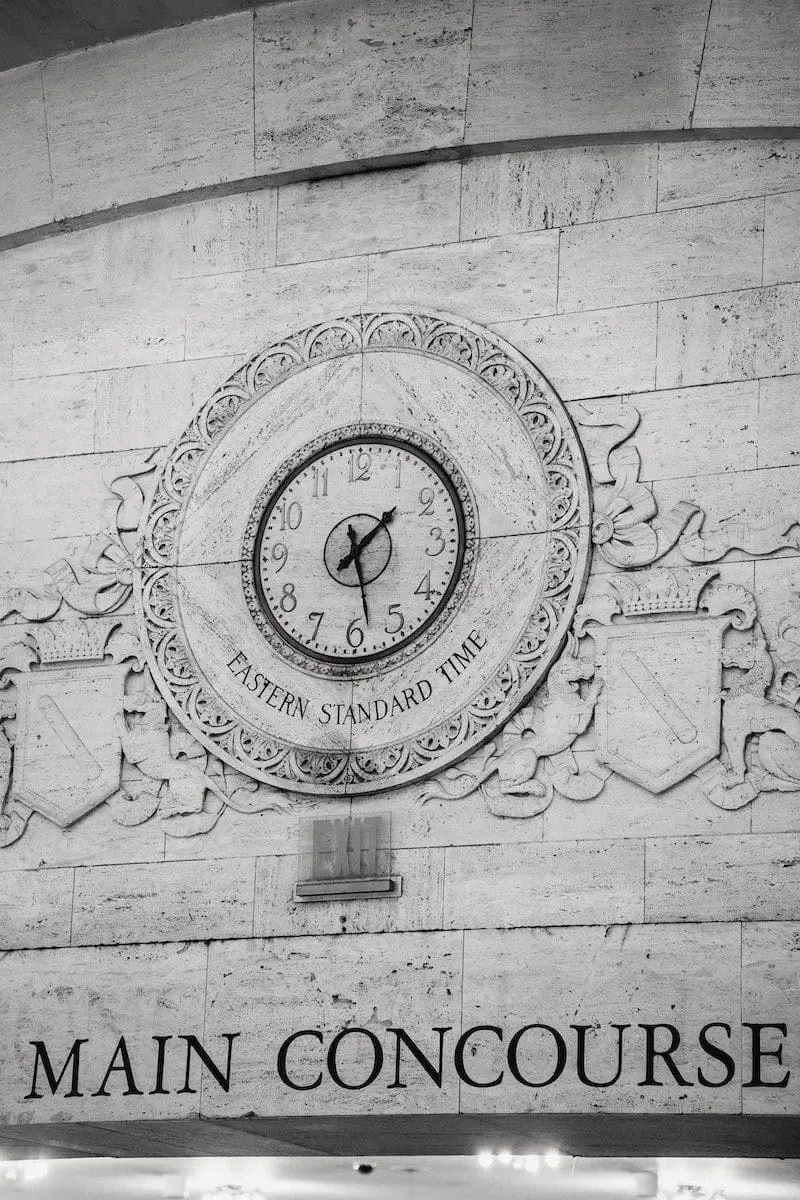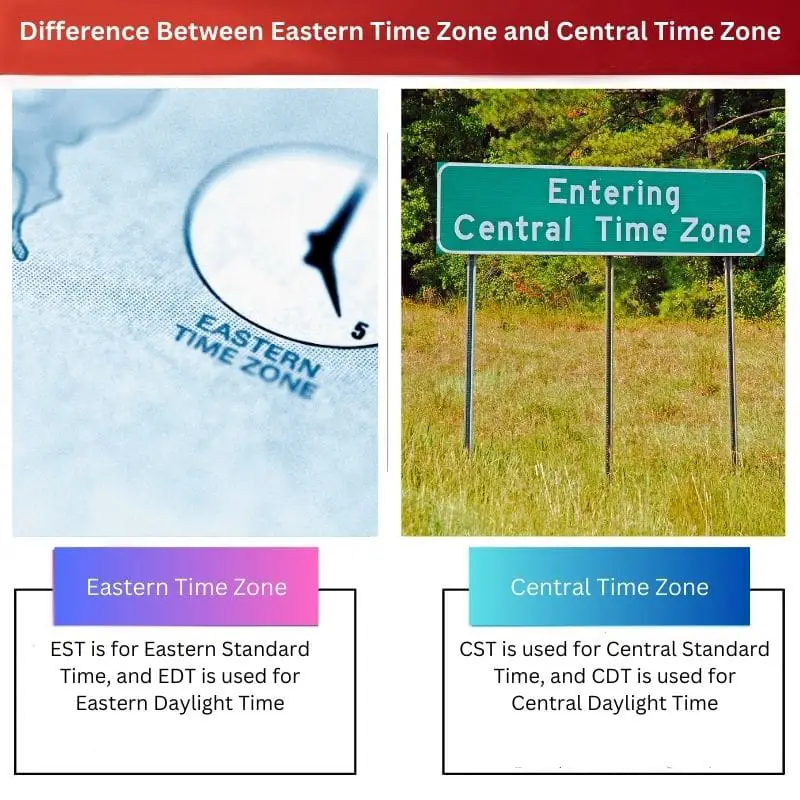The World is divided into several time zones, which means one country has a different time and another has an additional time. These are based on three factors that are:
- Sun
- Rotation of the Earth
- Revolutions of the Earth
For example, in the United States, different time zone is followed, such as the central time zone, Pacific Time, etc. All the time zones vary in time from the Coordinated Universal Time.
Key Takeaways
- Eastern Time Zone is 1 hour ahead of Central Time Zone.
- Eastern Time Zone is used by more people and covers more states than Central Time Zone.
- Several major cities, including New York and Washington D.C., use Eastern Time Zone, and several other major cities, including Chicago and Houston, use Central Time Zone.
Difference Between Eastern Time Zone and Central Time Zone
Eastern Time Zone is ahead of the time of the Central Time Zone. They run along with the different states, although there are few states through which both Eastern Time Zone and Central Time Zones pass.

Eastern Time Zone is the time zone of North America running along with the states which touch the Atlantic Ocean and is behind 5 hours (EST) and four hours (EDT) the coordinated Universal Time.
North America comes under the Central Time Zone on the left side of the Eastern Time zone, states that it does not touch the Atlantic Ocean and is behind 6 hours (CST) and 5 hours (CDT) of coordinated Universal Time.
Comparison Table for Eastern vs Central Time Zone
| Parameters of Comparison | Eastern Time Zone | Central Time Zone |
|---|---|---|
| Difference in Time | It is one hour ahead. | It is one hour behind. |
| Runs alongside | The eastern seaboard of the United States. | The left side of the states of the eastern time zone |
| Affect States | Florida, Georgia, Michigan, the Caribbean, parts of Canada, etc. | Minnesota to Louisiana, from Illinois to Kansas and Texas, also parts of Canada |
| Touches the Atlantic Ocean | It runs through all states that border the Atlantic Ocean. | It runs through states that do not touch the Atlantic Ocean. |
| Abbreviations | EST is for Eastern Standard Time, and EDT is used for Eastern Daylight Time | CST is used for Central Standard Time, and CDT is used for Central Daylight Time |
What is Eastern Time Zone?
Following are the countries that are part of the Eastern Time Zone:
- Canada: Ontario, Quebec, and Nunavut are several parts of Canada that come under the Eastern Time Zone.
- United States: Most of the United States comes under the Eastern Time Zone; states that entirely come under this are: Connecticut, Delaware, Georgia, Maine, Maryland, Massachusetts, New Hampshire, New Jersey, New York, North Carolina, Ohio, Pennsylvania, Rhode Island, South Carolina, Vermont, Virginia, and West Virginia; and the states that partially comes under this are: Florida, Indiana, Kentucky, Michigan, and Tennessee. Some other states also come under this, but it is not official yet.
- Mexico: only one state comes under this: Quintana Roo.
- Parts of the Caribbean Island are covered in the Eastern Time Zone.
- Turks and Caicos Island used to fall under it until 2015, then again covered under Eastern Time Zone after 2018.
- South America: parts of states like Acre, Amazon, Panama, Colombia, Peru, and Ecuador.
The borderline of this time zone shifted westwards after 1938.
Eastern Time Zone in North America
Geographical Coverage
The Eastern Time Zone (ET) is one of the standard time zones in North America. It is primarily observed in the eastern part of the continent, encompassing a significant portion of the United States and parts of Canada, Mexico, and the Caribbean.
The Eastern Time Zone covers the eastern seaboard in the United States, including New York, Florida, Georgia, and Maine. It extends westward to include states like Michigan, Ohio, and Indiana. The Canadian provinces of Ontario, Quebec, and parts of Nunavut also observe Eastern Time. Some Caribbean countries, such as the Bahamas and Haiti, also follow Eastern Time.
Daylight Saving Time
Daylight Saving Time (DST) is a practice followed in many regions to maximize daylight during the summer months. In the Eastern Time Zone, DST begins on the second Sunday in March, when clocks are moved forward by one hour. This change, called “springing forward,” results in longer evenings with more daylight.
DST in the Eastern Time Zone concludes on the first Sunday in November. At this time, clocks are turned back by one hour, an event known as “falling back.” The return to standard time ensures that mornings have more daylight during winter.
Observing Eastern Time Zone
Residents and businesses adjust their clocks accordingly to observe the Eastern Time Zone. This synchronization helps maintain uniformity and facilitates efficient communication and scheduling across regions within the time zone.
In the United States, the Eastern Time Zone is used by numerous major cities, including New York City, Miami, Atlanta, Boston, and Washington, D.C. These cities, along with many others, operate on Eastern Standard Time (EST) during non-Daylight Saving periods.
It’s important to note that while the Eastern Time Zone covers a vast geographical area, there may be exceptions and variations within certain regions. For example, some locations near the border between time zones may observe a different time zone due to proximity to neighboring areas.
Eastern Time Zone in International Context
Countries in Eastern Time Zone
The Eastern Time Zone (ET) extends beyond North America and is observed in various countries across the globe. In addition to the United States and Canada, several Caribbean nations and parts of South America also follow Eastern Time. Here are some countries that observe the Eastern Time Zone:
- United States: The Eastern Time Zone covers a significant portion of the United States, including New York, Florida, Georgia, and Maine. Major cities like New York City, Miami, and Atlanta operate on Eastern Time.
- Canada: Eastern Time is observed in the Canadian provinces of Ontario and Quebec. Cities such as Toronto, Ottawa, and Montreal adhere to this time zone.
- Bahamas: The islands of the Bahamas, situated in the Atlantic Ocean, observe Eastern Time. Popular tourist destinations like Nassau and Freeport operate on this time zone.
- Haiti: Located in the Caribbean, Haiti follows Eastern Time. The capital city, Port-au-Prince, and other major towns and cities in Haiti adhere to this time zone.
- Cuba: Some parts of Cuba, including the capital, Havana, also observe Eastern Time. However, it’s important to note that Cuba operates on Eastern Standard Time (EST) year-round, without implementing Daylight Saving Time.
- Turks and Caicos Islands: This British Overseas Territory in the Caribbean operates on Eastern Time. It includes islands such as Grand Turk and Providenciales.
Time Differences with Other Time Zones
The Eastern Time Zone experiences time differences with other time zones across the globe. Here are some notable time differences:
- Central Time Zone: The Central Time Zone is west of the Eastern Time Zone. It is observed in Chicago, Dallas, and Mexico City regions. Central Time is one hour behind Eastern Time during Standard Time and Daylight Saving Time.
- Mountain Time Zone: The Mountain Time Zone is further west than the Central Time Zone. It includes locations such as Denver, Phoenix, and Calgary. Mountain Time is two hours behind Eastern Time during Standard Time and one hour behind during Daylight Saving Time.
- Pacific Time Zone: Situated on the West Coast of North America, the Pacific Time Zone covers areas including Los Angeles, San Francisco, and Vancouver. Pacific Time is three hours behind Eastern Time during Standard Time and two hours behind during Daylight Saving Time.
- Greenwich Mean Time (GMT): GMT is the standard time at the Prime Meridian, running through Greenwich, London. The Eastern Time Zone is five hours behind GMT during Standard Time and four hours behind during Daylight Saving Time.
- Coordinated Universal Time (UTC): UTC is the global primary time standard. Eastern Time is four hours behind UTC during Standard Time and five hours behind during Daylight Saving Time.

What is Central Time Zone?
Following are the countries or regions that are part of the Central Time Zone:
Canada
- Province of Manitoba
- Nunavut territory (parts of Kivalliq and Qikiqtaaluk regions)
- Most features of Saskatchewan Province.
- And some other provinces partially do cover this time zone.
United States
- States that entirely are a part of the Central Time Zone are Oklahoma, Alabama, Arkansas, Illinois, Iowa, Louisiana, Minnesota, Mississippi, Missouri, and Wisconsin.
- States that are partially containing The Central Time Zone are Kansas, Texas, Florida, Indiana, Kentucky, Michigan, Nebraska, North Dakota, South Dakota, and Tennessee.
Mexico
Aguascalientes, Campeche, Coahuila, Oaxaca, Puebla, Querétaro, San Luis Potosí, State of Mexico, Durango, Guanajuato, Guerrero, Hidalgo, Jalisco, Mexico City, Michoacán, Morelos, Tabasco, Tamaulipas, Tlaxcala, Veracruz, Yucatán, parts of Colima, Chiapas, Nayarit (only a part), Nuevo León, Zacatecas.
Central America
States that use this time zone are:
- Belize
- Costa Rica
- El Salvador
- Nicaragua
- Honduras, and
- Guatemala.
Along with them, parts of Eastern Pacific Ocean islands and other areas also come under the Central Time Zone.
History of Central Time Zone
Early Timekeeping
Timekeeping and establishing time zones can be traced back to the development of accurate clocks and the need for consistent time measurement. In the early days, time was primarily determined by the sun’s position, with each location having its own local time based on the sun’s position at that specific longitude.
Railroad Time
The advent of railroads in the 19th century brought about the need for standardized time across regions to ensure efficient scheduling and safe operations. Before establishing time zones, each city or town would set its own local time based on its observations of the sun. This created a significant challenge for train schedules and coordination between railway lines.
In 1883, the major railroads of North America introduced a system known as “Railroad Time” or “Railway Time.” Under this system established four main time zones, including the Eastern, Central, Mountain, and Pacific Time Zones. The Central Time Zone was created to accommodate rail travel needs and encompassed a substantial portion of the central United States.
Standardization
Implementing the Central Time Zone and the other time zones brought about greater standardization in timekeeping across regions. It allowed for consistent scheduling of train departures and arrivals, making travel more reliable and efficient.
The Central Time Zone is centered on the 90th meridian, which runs through regions such as Chicago, Houston, and New Orleans. The boundaries of the Central Time Zone have been adjusted over the years to accommodate changes in the political and economic landscape.
Today, the Central Time Zone is observed in various countries and regions, including a significant portion of the United States, Mexico, Canada, and Central America. It is an essential part of coordinating activities, such as transportation, communication, and commerce, across the central region of North America.
Current Usage of Central Time Zone
Countries and Regions
The Central Time Zone (CT) is observed in several countries and regions worldwide. While its primary focus is in North America, it also extends into Central America and the Caribbean. Here are some countries and regions that utilize the Central Time Zone:
- United States: The Central Time Zone covers a significant portion of the United States, including states such as Texas, Louisiana, Illinois, Wisconsin, and Iowa. It also includes parts of states like Michigan, Kansas, Nebraska, and Minnesota.
- Mexico: The Central Time Zone is observed in several states in Mexico, including Quintana Roo, Campeche, Yucatan, and parts of Chiapas, Tabasco, and Veracruz.
- Canada: A small part of Canada, specifically the province of Saskatchewan, follows Central Standard Time (CST) year-round.
- Central America: Certain countries in Central America, such as Belize, Costa Rica, El Salvador, Guatemala, Honduras, and Nicaragua, operate on Central Time.
- Caribbean: Some islands in the Caribbean utilize the Central Time Zone, including the Cayman Islands and parts of the Bahamas.
Major Cities
Numerous major cities are situated within the Central Time Zone, playing significant roles in commerce, culture, and tourism. Here are some notable cities in the Central Time Zone:
- Chicago, United States: As one of the largest cities in the United States, Chicago is a major economic and cultural hub in the Central Time Zone.
- Houston, United States: In Texas, Houston is known for its strong presence in the energy industry and is home to the NASA Space Center.
- Mexico City, Mexico: As the capital of Mexico, Mexico City is a vibrant metropolis with rich history, culture, and a thriving economy.
- New Orleans, United States: Famous for its unique music, cuisine, and festivals, New Orleans is a culturally diverse city that attracts visitors from around the world.
- San Salvador, El Salvador: As the capital of El Salvador, San Salvador is an important political, economic, and cultural center in Central America.
Business and Travel
The Central Time Zone has significant implications for business and travel. With major cities and economic centers operating in this time zone, business activities, trade, and financial transactions are conducted based on Central Time.
Regarding travel, the Central Time Zone provides a reference point for scheduling flights, train departures, and other transportation arrangements. Travelers can plan their itineraries and coordinate their activities based on the time zone to ensure smooth transitions and timely arrivals.
It’s important to note that the Central Time Zone observes Daylight Saving Time, where clocks are set forward by one hour during the summer months to extend daylight hours. This practice impacts businesses and travelers regarding scheduling and adjusting to the time changes.
Main Differences Between Eastern Time Zone and Central Time Zone
- Eastern Time Zones affect various states that touch the Atlantic Ocean, for example, Florida, Georgia, Michigan, the Caribbean, parts of Canada, etc., and Central Time Zones affect conditions that do not touch the Atlantic Ocean, such as Minnesota – Louisiana, Illinois, Kansas, and also some parts of Canada.
- EST (Eastern Standard Time) is the abbreviation for the Eastern Time Zone, and CST (Central Standard Time) is for the Central Time Zone.




